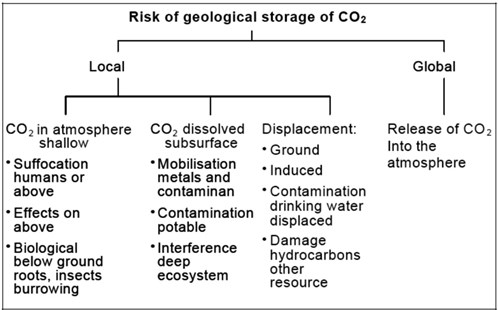Health, safety and environmental (HSEHealth, safety and environment) risks fall into two main categories: global risks and local risks as presented in Fig. 6-2 for geological storage(CO2) A process for retaining captured CO2, so that it does not reach the atmosphere of CO2Carbon dioxide (Chadwick et al., 2008).
| 
Fig. 6-2: Health, safety and environmental (HSEHealth, safety and environment) risks associated with geological storage(CO2Carbon dioxide) A process for retaining captured CO2Carbon dioxide, so that it does not reach the atmosphereThe layer of gases surrounding the earth; the gases are mainly nitrogen (78%) and oxygen (around 21%) of CO2Carbon dioxide. After Wilson et al., 20032003 - E. J. Wilson, T. L. Johnson and D. W. KeithRegulating the ultimate sink: Managing the risks of geologic CO2 storagesee more and Chadwick et al., 2008. |
The global risks are related to release of CO2Carbon dioxide to the atmosphereThe layer of gases surrounding the earth; the gases are mainly nitrogen (78%) and oxygen (around 21%) that might contribute significantly to climate change in case a significant amount leaks from the storage(CO2) A process for retaining captured CO2, so that it does not reach the atmosphere formationA body of rock of considerable extent with distinctive characteristics that allow geologists to map, describe, and name it to the atmosphereThe layer of gases surrounding the earth; the gases are mainly nitrogen (78%) and oxygen (around 21%). Predicting the global impact on climate change due to a release of CO2Carbon dioxide depends on the quantity, duration and timing of the release (IPCCIntergovernmental Panel on Climate Change, 2005; Chadwick et al., 2008; WRI, 20082008 - WRIGuidelines for CCSsee more).
Local health, safety and environmental hazards might arise from three main causes: (i) direct effects of elevated gas-phase CO2Carbon dioxide concentrations in the shallow subsurface and near-surface environment, (ii) effects of dissolved CO2Carbon dioxide on groundwater chemistry, and (iii) effects that arise from the displacement of fluids by the injected CO2Carbon dioxide (IPCCIntergovernmental Panel on Climate Change, 2005). Local environmental impacts resulting from a release of CO2Carbon dioxide will depend more on the duration, the spatial and temporal distribution of fluxes and the resulting CO2Carbon dioxide concentrations and the ambient conditions than on the total amount of CO2Carbon dioxide released (IPCCIntergovernmental Panel on Climate Change, 2005; Chadwick et al., 2008).
The main local HSEHealth, safety and environment riskConcept that denotes the product of the probability of a hazard and the subsequent consequence of the associated event of concern to humans is elevated CO2Carbon dioxide concentrations in the atmosphereThe layer of gases surrounding the earth; the gases are mainly nitrogen (78%) and oxygen (around 21%). Although CO2Carbon dioxide is non-toxic, it can be dangerous to life when concentrations are higher than 7-10% in volume because of resultant reductionThe gain of one or more electrons by an atom, molecule, or ion in oxygen concentrations, causing unconsciousness, change of blood pH and failure of respiratory muscles. For humans, concentrations above 50,000 ppm can cause unconsciousness, with possible death at concentrations above 100,000 ppm. Such concentrations might arise in the case of sudden leaks from wellManmade hole drilled into the earth to produce liquids or gases, or to allow the injection of fluids blowouts (IPCCIntergovernmental Panel on Climate Change, 2005; Chadwick et al., 2008; WRI, 20082008 - WRIGuidelines for CCSsee more).
Potential HSEHealth, safety and environment risks should be distinguished between onshore and offshore storage(CO2) A process for retaining captured CO2, so that it does not reach the atmosphere settings, since unwanted effects may have more severe consequences in densely populated areas and in environmentally sensitive locations than in sparsely utilised rural areas or offshore (Chadwick et al., 2008).